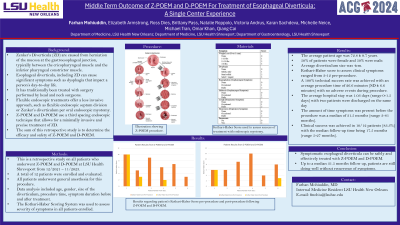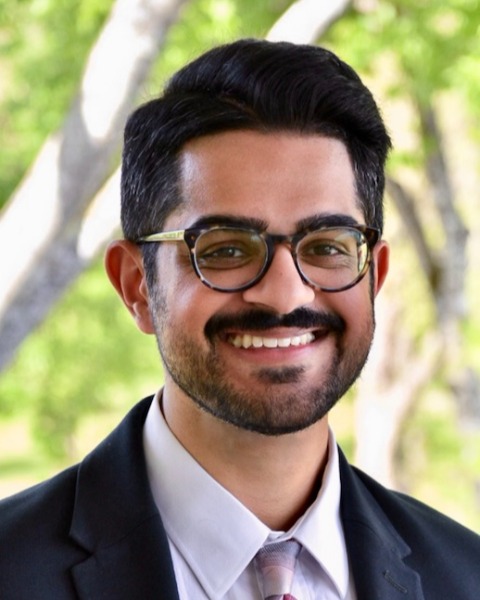Tuesday Poster Session
Category: Esophagus
P3939 - Middle Term Outcome of Z-POEM and D-POEM For Treatment of Esophageal Diverticula: A Single Center Experience
Tuesday, October 29, 2024
10:30 AM - 4:00 PM ET
Location: Exhibit Hall E

Has Audio

Farhan Mohiuddin, MD
Ochsner LSU Health
New Orleans, LA
Presenting Author(s)
Farhan Mohiuddin, MD1, Elizabeth Armstrong, MD2, Ross Dies, MD3, Britanny Pass, BS4, Natalie Roppolo, MS4, Victoria Andrus, MD3, Karan Sachdeva, MD4, Michelle Neice, MD4, Michael Tran, MD4, Omar Khan, MD4, Qiang Cai, MD4
1Ochsner LSU Health, New Orleans, LA; 2LSU Health, Baton Rouge, LA; 3Ochsner LSU Health, Shreveport, LA; 4LSU Health, Shreveport, LA
Introduction: Esophageal diverticula, including Zenker’s Diverticula (ZD) can cause significant symptoms that impact a person’s day-to-day life. ZD is caused by a herniation of the mucosa at the pharyngoesophageal junction, typically between the cricopharyngeal muscle and the inferior pharyngeal constrictor muscle. It often presents with significant dysphagia and has traditionally been treated with surgery performed by head and neck surgeons. Flexible endoscopic treatments offer a less invasive approach, such as Flexible endoscopic septum division (FESD) or Zenker’s and diverticulum per oral endoscopic myotomy (Z-POEM and D-POEM). Z-POEM and D-Poem use a third-spacing endoscopic technique that allow for a minimally invasive and precise treatment of ZDs and diverticulum. The aim of this retrospective study is to determine the middle team outcome of Z-POEM and D-POEM.
Methods: This is a retrospective study on all patients who underwent Z-POEMs and D-POEMs at LSU Health Shreveport Ochsner Hospital. Patients’ symptoms before and after the procedure are assessed using the Kothari-Haber scoring system. Age, gender, size of the diverticulum, procedure time, symptomatic duration before Z-POEM and the length of follow up post Z-POEM will also be included. All patients underwent general anesthesia for this procedure.
Results: A total of 12 patients have been enrolled. The average patient age ± standard deviation was 72.8 ± 9.7 years. 50% (n=6) were females and 50% were males (n=6). The average diverticulum was 4.0 cm (range 3-5 cm). The Kothari-Haber score was used to assess clinical symptoms prior to the procedure and the values ranged from 3-12 (median = 6.5). A 100% technical success rate was achieved with an average procedure time of 26.6 minutes (SD ± 6.6 minutes) and no adverse events. The average hospital stay was 1.03 days (range 0-1.5 days). Two patients were discharged on the same day. The amount of time symptoms was present before the procedure was a median of 31.5 months (range 3-81 months). Clinical success was achieved in 10/12 patients (83.3%) with the median follow-up time being 17.5 months (range 5-27 months). There is a significant reduction in the Kothari-Haber Score after Z-POEM and D-POEM (P-value = 0.0006).
Discussion: Symptomatic esophageal diverticula can be safely and effectively treated with Z-POEM and D-POEM. Up to a median 31.5 months follow up, patients are still doing very well without recurrence of symptoms.
Disclosures:
Farhan Mohiuddin, MD1, Elizabeth Armstrong, MD2, Ross Dies, MD3, Britanny Pass, BS4, Natalie Roppolo, MS4, Victoria Andrus, MD3, Karan Sachdeva, MD4, Michelle Neice, MD4, Michael Tran, MD4, Omar Khan, MD4, Qiang Cai, MD4. P3939 - Middle Term Outcome of Z-POEM and D-POEM For Treatment of Esophageal Diverticula: A Single Center Experience, ACG 2024 Annual Scientific Meeting Abstracts. Philadelphia, PA: American College of Gastroenterology.
1Ochsner LSU Health, New Orleans, LA; 2LSU Health, Baton Rouge, LA; 3Ochsner LSU Health, Shreveport, LA; 4LSU Health, Shreveport, LA
Introduction: Esophageal diverticula, including Zenker’s Diverticula (ZD) can cause significant symptoms that impact a person’s day-to-day life. ZD is caused by a herniation of the mucosa at the pharyngoesophageal junction, typically between the cricopharyngeal muscle and the inferior pharyngeal constrictor muscle. It often presents with significant dysphagia and has traditionally been treated with surgery performed by head and neck surgeons. Flexible endoscopic treatments offer a less invasive approach, such as Flexible endoscopic septum division (FESD) or Zenker’s and diverticulum per oral endoscopic myotomy (Z-POEM and D-POEM). Z-POEM and D-Poem use a third-spacing endoscopic technique that allow for a minimally invasive and precise treatment of ZDs and diverticulum. The aim of this retrospective study is to determine the middle team outcome of Z-POEM and D-POEM.
Methods: This is a retrospective study on all patients who underwent Z-POEMs and D-POEMs at LSU Health Shreveport Ochsner Hospital. Patients’ symptoms before and after the procedure are assessed using the Kothari-Haber scoring system. Age, gender, size of the diverticulum, procedure time, symptomatic duration before Z-POEM and the length of follow up post Z-POEM will also be included. All patients underwent general anesthesia for this procedure.
Results: A total of 12 patients have been enrolled. The average patient age ± standard deviation was 72.8 ± 9.7 years. 50% (n=6) were females and 50% were males (n=6). The average diverticulum was 4.0 cm (range 3-5 cm). The Kothari-Haber score was used to assess clinical symptoms prior to the procedure and the values ranged from 3-12 (median = 6.5). A 100% technical success rate was achieved with an average procedure time of 26.6 minutes (SD ± 6.6 minutes) and no adverse events. The average hospital stay was 1.03 days (range 0-1.5 days). Two patients were discharged on the same day. The amount of time symptoms was present before the procedure was a median of 31.5 months (range 3-81 months). Clinical success was achieved in 10/12 patients (83.3%) with the median follow-up time being 17.5 months (range 5-27 months). There is a significant reduction in the Kothari-Haber Score after Z-POEM and D-POEM (P-value = 0.0006).
Discussion: Symptomatic esophageal diverticula can be safely and effectively treated with Z-POEM and D-POEM. Up to a median 31.5 months follow up, patients are still doing very well without recurrence of symptoms.
Disclosures:
Farhan Mohiuddin indicated no relevant financial relationships.
Elizabeth Armstrong indicated no relevant financial relationships.
Ross Dies indicated no relevant financial relationships.
Britanny Pass indicated no relevant financial relationships.
Natalie Roppolo indicated no relevant financial relationships.
Victoria Andrus indicated no relevant financial relationships.
Karan Sachdeva indicated no relevant financial relationships.
Michelle Neice indicated no relevant financial relationships.
Michael Tran indicated no relevant financial relationships.
Omar Khan indicated no relevant financial relationships.
Qiang Cai indicated no relevant financial relationships.
Farhan Mohiuddin, MD1, Elizabeth Armstrong, MD2, Ross Dies, MD3, Britanny Pass, BS4, Natalie Roppolo, MS4, Victoria Andrus, MD3, Karan Sachdeva, MD4, Michelle Neice, MD4, Michael Tran, MD4, Omar Khan, MD4, Qiang Cai, MD4. P3939 - Middle Term Outcome of Z-POEM and D-POEM For Treatment of Esophageal Diverticula: A Single Center Experience, ACG 2024 Annual Scientific Meeting Abstracts. Philadelphia, PA: American College of Gastroenterology.

